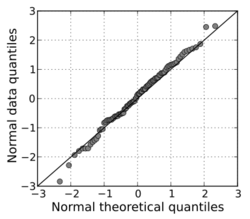Identity line


In a 2-dimensional Cartesian coordinate system, with x representing the abscissa and y the ordinate, the identity line[1][2] or line of equality[3] is the y = x line. The line, sometimes called the 1:1 line, has a slope of 1.[4] When the abscissa and ordinate are on the same scale, the identity line forms a 45° angle with the abscissa, and is thus also, informally, called the 45° line.[5] The line is often used as a reference in a 2-dimensional scatter plot comparing two sets of data expected to be identical under ideal conditions. When the corresponding data points from the two data sets are equal to each other, the corresponding scatters fall exactly on the identity line.[6]
In economics, an identity line is used in the Keynesian cross diagram to identify equilibrium, as only on the identity line does aggregate demand equal aggregate supply.[7]
References
- ↑ Ciesielski, Krzysztof (1997), Set Theory for the Working Mathematician, London Mathematical Society Student Texts, 39, Cambridge University Press, p. 13, ISBN 9780521594653, https://books.google.com/books?id=tTEaMFvzhDAC&pg=PA13.
- ↑ Feinstein, Alvan R. (2001), Principles of Medical Statistics, CRC Press, p. 301, ISBN 9781420035681, https://books.google.com/books?id=pQ-jRsoBi5YC&pg=PA301.
- ↑ Kotz, Samuel; Read, Campbell B.; Banks, David L. (1997), Encyclopedia of statistical sciences: Update, Volume 1, Wiley, p. 455, ISBN 9780471118367, https://archive.org/details/encyclopediaofst0001unse/page/455.
- ↑ Sterner, Robert Warner; Elser, James J. (2002), Ecological Stoichiometry: The Biology of Elements from Molecules to the Biosphere, Princeton University Press, p. 16, ISBN 9780691074917, https://books.google.com/books?id=53NTDvppdYUC&pg=PA16.
- ↑ Challis, N.; Gretton, H. (2008), Fundamental Engineering Mathematics: A Student-Friendly Workbook, Elsevier, p. 38, ISBN 9780857099396, https://books.google.com/books?id=RuiiAgAAQBAJ&pg=PA38.
- ↑ van Aartsengel, Aristide; Kurtoglu, Selahattin (2013), Handbook on Continuous Improvement Transformation: The Lean Six Sigma Framework and Systematic Methodology for Implementation, Springer, p. 224, ISBN 9783642359019, https://books.google.com/books?id=DUFEAAAAQBAJ&pg=PA224.
- ↑ Michl, Thomas R. (2002), "3.6 The Keynesian cross", Macroeconomic Theory: A Short Course, M. E. Sharpe, pp. 35–36, ISBN 9780765611413, https://books.google.com/books?id=fPQKcV7ARqwC&pg=PA35.
 |
